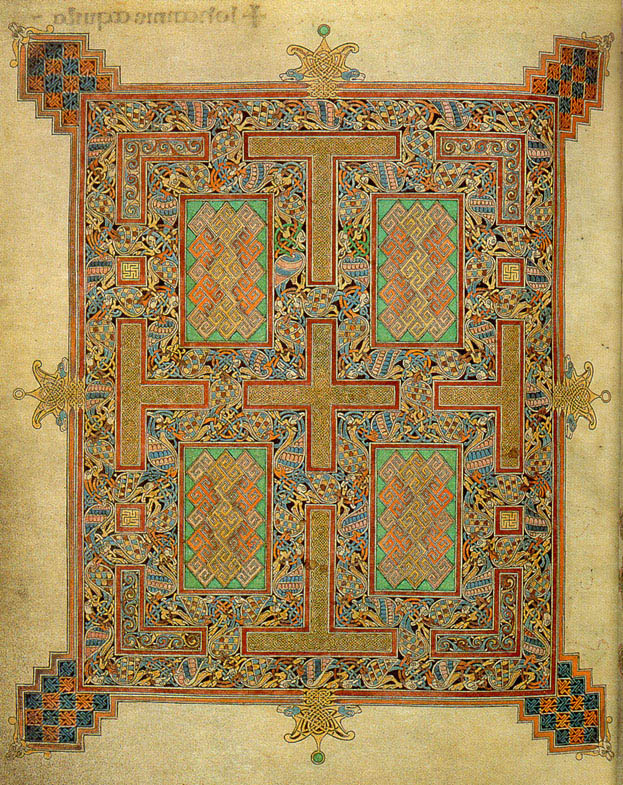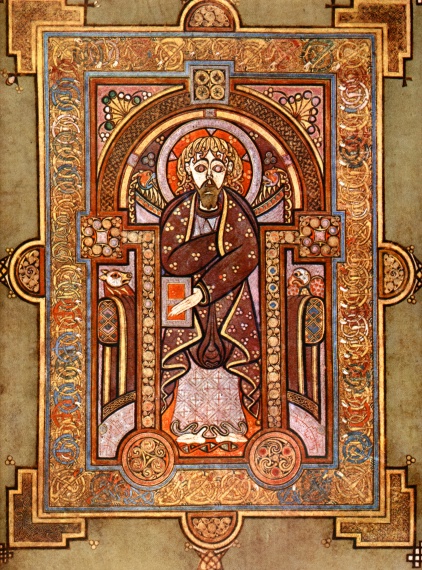Weekly Research
I have recently become obsessed with typography and took a class on it last year where I learned how to write in Gothic style with a calligraphy pen. I found it very difficult and struggled to create a steady form throughout the alphabet. Though I know it’s not the same, this week as we observed various codices with complex illuminations and perfectly crafted uncials, I found myself holding a deeper respect for the creators of such masterpieces. I was especially drawn to the Celtic codices, for example The Book of Kells and The Celtic Psalter. The influence of other cultures on these pieces make their appearance unique and in some ways modern as bright colours are included. The text itself is carefully sculpted to be consistent throughout, which I admire. I am sure to draw inspiration from these two pieces in particular for future projects.
Celtic Illuminations
Art has been used as a storytelling tool throughout history. A great many pieces have been based around Christianity and has been one of the primary ways to pass down different styles and ways of approaching similar scenarios. The forms of communication can vary from paintings to cloth tapestries, and also various manuscripts. I have taken particular interest in the Celtic renditions of the bible and the style in which they approach illumination.
The Irish approached their illuminations with style and precision, the best example of this is the Book of Kells. As author Michael Slavin illustrates, it took a massive team of multiple scribes and illuminators in order to achieve such complex detail (Slavin 136). The inspiration for this codex was drawn from influences worldwide, and in turn inspired many in their distinctive creation.
Celtic Illuminations were unique because they both played the part as influencer and influenced in the creation of art.
Influenced
Many of the codices created in Ireland had a mixed flair of both Celtic traditions and inspired worldly art. As stated in the Britannica Concise Encyclopedia, “It mingled the Celtic decorative tradition… with… patterns and bright coloration of the pagan Anglo-Saxons” (BCE). One can see this effect later works and how illuminators approached carpet pages and marginalia (fig 1).
There was also the influence from traditional Mediterranean art which introduced the human figure in art objects. This resulted in the creation of geometric manuscripts mixed with areas of bright colour and interlaced designs (BCE). The Book of Kells and the Lindisfarne Gospels are both incredible examples of how the Irish were able to incorporate their inspirations with their unique style.
Figure 1: Lindisfarne Gospels carpet page
Influencer
Celtic illuminations have changed the way others have approached visual storytelling. Up until the creation of the Book of Ballymote all work “had been the preserve of the Celtic monasteries” (Slavin 46). So it was distinctive to Celtic codices to be created by professional historians and scribes.
A bright colour choice differentiates Celtic Illuminations as well. Techniques were used for a long-lasting affect, for example the use of egg white as a binding material (Slavin 137)
Figure 2: Book of Kells illuminated letters
There was also many different tools used in the creation of the illustrations that allowed for more precision and accuracy. This included:
- the feather quill (from either goose or swan)
- sharp wooden instrument
- a stylus or silver point with a very thin brush
- mechanical elements (rulers, compasses, set squares, etc.)
These materials were thought to have been used for the Book of Kells. The tools assisted in setting a high standard for illumination, and carried this standard out internationally. This is portrayed when Irish missionaries carried over the influence to Europe and specifically in Carolingian art.
Figure 3: Book of Kells portrait illumination
Conclusion
I think Slavin, speaking on the Book of Kells, summarizes my thoughts well, “This is illumination at its very best, which has set the standard for Irish script from that time until now” (Slavin 137). Celtic Illumination has been influenced by other cultures’ approaches as many artists are. But it has also shown an innovative approach to art.
–
Work Cited
https://en.wikipedia.org/wiki/Book_of_Kells
http://www.visual-arts-cork.com/cultural-history-of-ireland/book-of-kells.htm
“Hiberno-Saxon style.” Britannica Concise Encyclopedia, Encyclopaedia Britannica, Britannica Digital Learning, 2017. Credo Reference, https://ezproxy.capilanou.ca/login?url=https://search.credoreference.com/content/entry/ebconcise/hiberno_saxon_style/0?institutionId=6884. Accessed 26 Sep. 2018.
Slavin, Michael. The Ancient Books of Ireland. Montreal [Que.] : McGill-Queen’s University Press, c2005 (Ottawa, Ontario : Canadian Electronic Library, 2010), 2005. EBSCOhost, ezproxy.capilanou.ca/login?url=https://search.ebscohost.com/login.aspx?direct=true&db=cat02755a&AN=cul.b969857&site=eds-live&scope=site.


